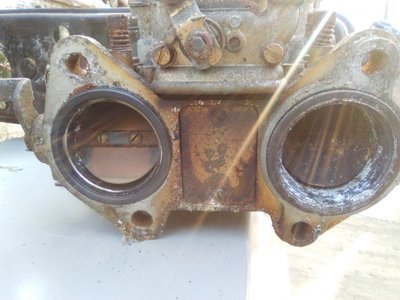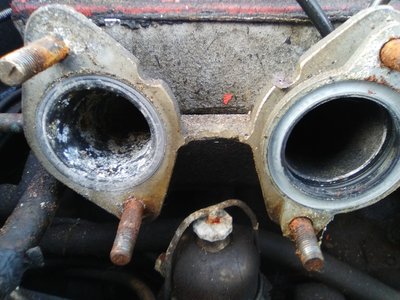Deposits in intake manifold for cyl #4 - (Elan +2S Weber)
6 posts
• Page 1 of 1
Hi
I'm stripping my 1969 Elan +2S and today took off the carbs (Weber 40 DCOE). The engine seized many years ago, and I still don't know why, so I'm hoping to diagnose things as I go.
You can see in cylinder 4 some white deposits around the inlet manifold. They are also visible on the back of No 4 carb. All other ports and carbs are nice and clean.
When I took the Girling brake servo off the other day, it was clearly full of brake fluid (in fact, it was still at pressure after 35 years! I had to cut the brake pipe and a jet of fluid came out).
I believe that if the non-return valve is faulty, brake fluid can get into the manifold, and I guess it makes the most difference on #4 cylinder.
Can anyone confirm that this is what I'm seeing?
Thanks
Ned
I'm stripping my 1969 Elan +2S and today took off the carbs (Weber 40 DCOE). The engine seized many years ago, and I still don't know why, so I'm hoping to diagnose things as I go.
You can see in cylinder 4 some white deposits around the inlet manifold. They are also visible on the back of No 4 carb. All other ports and carbs are nice and clean.
When I took the Girling brake servo off the other day, it was clearly full of brake fluid (in fact, it was still at pressure after 35 years! I had to cut the brake pipe and a jet of fluid came out).
I believe that if the non-return valve is faulty, brake fluid can get into the manifold, and I guess it makes the most difference on #4 cylinder.
Can anyone confirm that this is what I'm seeing?
Thanks
Ned
+2S 1969 50/2283
-

NedK - Second Gear

- Posts: 99
- Joined: 31 Aug 2015
Certainly nothing to do with the non return valve as it's operating the other way around, preventing the servo losing vacuum when manifold vacuum drops. I suppose a major leak in the servo hydraulics could flood the vacuum pod and then be sucked into the manifold, but I've never heard of it.
No 4 is nearest the breather pipe in the air box so is likely to suffer most from any excess breather pressure - e.g. worn valve guides, worn or broken piston rings or blown head gasket.
Dougal.
No 4 is nearest the breather pipe in the air box so is likely to suffer most from any excess breather pressure - e.g. worn valve guides, worn or broken piston rings or blown head gasket.
Dougal.
- dougal9887
- Third Gear

- Posts: 244
- Joined: 23 Aug 2013
Breather condensation from the engine being run for a short period and then left for several months before the next run.
Probably the car was in storage and started occasionally but not run long enough or under power.
If the deposit is also upstream of the butterfly then it would be an engine stored outside (or with the bonnet off and outside) with a damaged K&N type air filter, I bought an accident damaged car where that had happenen in the breakers yard, the deposit was identical but the water had also got into the bore of the cylinder causing real rather than cosmetic damage.
Probably the car was in storage and started occasionally but not run long enough or under power.
If the deposit is also upstream of the butterfly then it would be an engine stored outside (or with the bonnet off and outside) with a damaged K&N type air filter, I bought an accident damaged car where that had happenen in the breakers yard, the deposit was identical but the water had also got into the bore of the cylinder causing real rather than cosmetic damage.
- Chancer
- Coveted Fifth Gear

- Posts: 1132
- Joined: 20 Mar 2012
Agree that what you are looking at is consistent with water damage. If it had been brake fluid, it would look considerably nicer in there. 
Suggests a good reason not to turn the engine over until the head is off and the extent of cylinder/piston damage can be assessed.
It's somewhat scary to hear that a simple act like occasional starting can result in this.
Suggests a good reason not to turn the engine over until the head is off and the extent of cylinder/piston damage can be assessed.
It's somewhat scary to hear that a simple act like occasional starting can result in this.
- denicholls2
- Fourth Gear

- Posts: 550
- Joined: 23 Jan 2006
Combustion produces lots of water vapour even when the relative humidity is low, an engine really needs to be "worked" for some time at running temperature to rid itself of the moisture and even then it can remain in the form of mayonnaise in the breather tracts.
- Chancer
- Coveted Fifth Gear

- Posts: 1132
- Joined: 20 Mar 2012
6 posts
• Page 1 of 1
Total Online:
Users browsing this forum: No registered users and 21 guests


